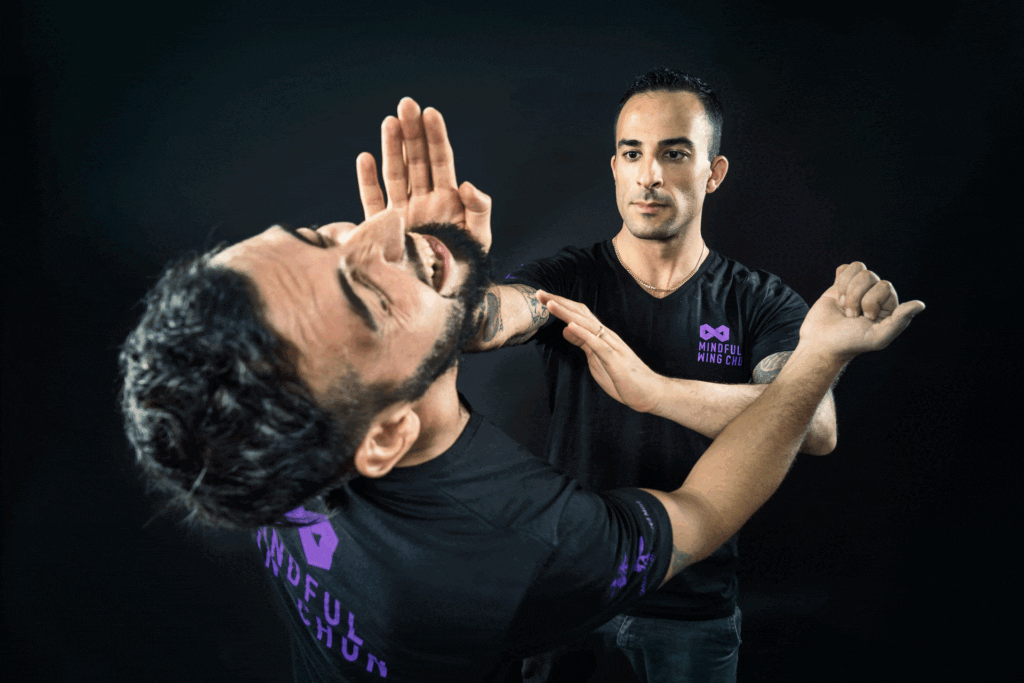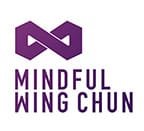Wing Chun is a martial arts system rather than a martial arts style. The word “style” implies that practitioners are merely copying a set of movements, whereas the word “system” implies that there’s a set of principles behind the way the movements are carried out. These principles can be applied in any self-defense situation, which is why many teachers of other martial arts styles come to Mindful Wing Chun from all over the world to learn this logical set of principles that they can implement in their own styles.

Simply stated, with Wing Chun you’ll be able to defend yourself effectively and quickly, regardless of your size, strength, age or gender. This is because Wing Chun makes use of the laws of physics:
Force = Mass x Acceleration
This means that if you maximise these two factors and deliver force through the natural shapes and mechanics, you can tap into your full potential power without having to rely on brute (muscular) force.
Mindful Relaxation
So how can you maximise the use of your body’s mass and speed? Through mindful relaxation! We learn mindful relaxation through the correct practice of the Forms. Muscular tension can internally block the joints so that force can’t travel through them freely, much like the way water cannot travel through a blocked drain. So when you can relax your muscles you’ll be able to use your mind to produce and withstand force with all the joints of your body, and therefore use the interconnected and holistic sum of your body mass.
If, for example, I weigh 80kgs but I’m able to use only10kgs of force in a movement, whereas you weigh 60kgs but, through the method of mindful relaxation, you can use 30kgs in the movement, you’ll be able to overpower me even though you’re much smaller than me. Mindful relaxation also improves your speed tremendously. When there’s muscular tension around the joints, it’s like having the handbrake on while you’re driving, so by releasing the tension the joints become free-moving and you can accelerate much faster with much less effort.
Furthermore, Wing Chun uses nature’s geometrical laws and correct body mechanics for the efficient use of energy:
Multi-directional Power
By using mindful relaxation, not only do we get freedom of movement in our joints, we also get access to the joints in such a way that we’re able to individually “rotate” them independently of their surrounding joints.
Have a look at the following video to see the results and power that can be generated when the joints are used this way:
Straight Line
In Wing Chun we always take the shortest and most efficient path to the target, which is obviously a straight line. This aspect of Wing Chun movements means that we actually need to move much more slowly than our opponent to cover the same distance (if they’re not moving along a straight path).
Triangle in Self-Defense
The Stance and Guard of Wing Chun are such that they create a triangular shape, which makes it very efficient in terms of both producing outward energy and of redirecting any incoming force from the opponent. A triangle/pyramid is the best shape in nature for doing this. For example, a triangle/pyramid-shaped object is the most aerodynamic shape, which is why an arrow (the kind used with a bow) is shaped the way it is.
The use of a triangular shape in our stance also makes it easier for the Wing Chun practitioner to focus his/her mass and intention towards one point (the apex of the triangle).
Circle / Sphere
It’s common knowledge that a circular/sphere-shaped object is the most efficient one for the absorption and redirection of force. All Wing Chun movements have a circular aspect to them, because the joints all naturally move the bone in the shape of an arc (i.e., when the shoulder joint swings freely, the elbow swings in an arc). We also take advantage of the circular structure by developing and maintaining our “optimum angle” in the structures of the arms and legs. This creates a physical circular structure, which enables us to absorb and redirect the opponent’s incoming force with minimum effort. These circular techniques are very easily observed in the practice of Wing Chun’s Chi Sau exercise.
Fulcrum Point In Self-Defense
In Wing Chun, rather than pushing or pulling at the point of contact with the opponent, we try to make the point of contact a fulcrum point, to ensure we get maximum leverage and minimum resistance. In the arms, this usually happens when our forearm comes into contact with the opponent’s forearm, and for the legs it’s usually the point of contact of our shin with any part of the opponent’s leg.
To better understand this, let’s look at an example. Imagine you’re holding up a Long Pole, right at the middle, with both hands, to you try and stop it from moving. Then we ask two 10-year-old kids to each hold the pole, with one at each end, while you’re still holding it at its centre. If we ask both kids to walk in the same direction, you have a very good chance of stopping them from moving the pole because you’d be able to feel the direction they are moving in and directly oppose it with your force. However, if they both start walking in opposite directions, suddenly the contact point is not moving and it becomes the axis or pivot point of the movement. As a result, it will be almost impossible to stop them from moving the pole.
To Summarize About Self-Defense
Wing Chun movements create multi-vector forces that have the backing of a springy triangle, they have the absorption and redirection abilities of circles, they move along straight paths to the target, and they always “go around” the contact point. This is why, even without achieving a high level in Wing Chun, a practitioner can effectively defend himself or herself with correct mechanics applied through the principles.
A good example of this is our very own Head Sifu Nima King, who for a few years worked as a bouncer in Sydney before moving to Hong Kong in the early 2000s. During this period, Nima was merely practising and applying the external mechanics and principles of Wing Chun described above, which proved very effective for altercations and self-defense situations he came across as a bouncer.
Having said that, self-defense becomes effortless for those who delve deeper into the art and go beyond the mere mechanics and structure of the Wing Chun movement to explore the realm of the mind through correct and persistent practice of Wing Chun’s first Form, Siu Nim Tao. Our teacher, Grandmaster Chu Shong Tin, who was named “The King of Siu Nim Tao” by his teacher Ip Man, was at the very pinnacle of this “Nim Tao State” and had so much control that he never needed to strike more than once in the many challenge fights he had.
Here’s a video of him in a seminar at Mindful Wing Chun, talking about those days:



